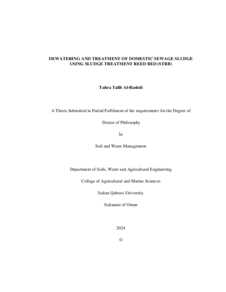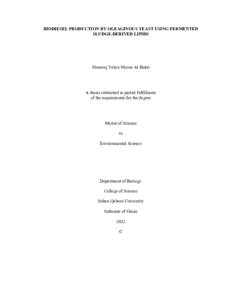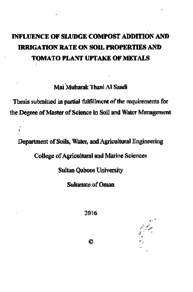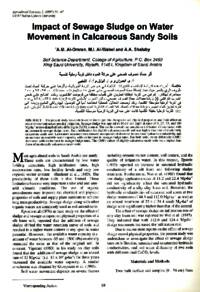وثيقة
Dewatering and treatment of domestic sewage sludge using Sludge Treatment Reed Bed (STRB).
المصدر
Doctoral dissertation
عناوين أخرى
تجفيف المياه ومعالجة حمأة الصرف الصحي باستخدام أحواض القصب لمعالجة الحمأة
الدولة
Oman
مكان النشر
Muscat
الناشر
Sultan Qaboos University
ميلادي
2024
اللغة
الأنجليزية
نوع الرسالة الجامعية
Doctoral dissertation
الملخص الإنجليزي
Sultanate of Oman produces huge amount of wastewater which is coupled with the
production of sludge water. Sludge is simply defined as a mixture of water, organic
matter and inorganic matter resulting from the biological treatment of wastewater. The
mixture then is dried and converted to solid cake. Eighty-four percent of the sludge
produced by various Sewage Treatment Plants (STPs) is disposed of in landfills, while
the remaining 16% is directed to the composting plant. Therefore, a significant amount
of funds is allocated to produce compost of a specific and desired quality. For this
reason, innovative and cost-effective means and ways should be used to manage the
sludge for environmentally friendly sound disposal. In the effort to identify sustainable
sludge management options, pilot-scale Sludge Treatment Reed Beds (STRBs) were
tested and assessed in the Sultanate of Oman in the first integrated experimental study
of this nature-based solution in the Middle East region. A total of eighteen pilot STRB
units were established and monitored for almost two years; half were planted with
native Phragmites australis reed species and half served as unplanted control units.
Employing a randomized complete block design, the study examined varying sludge
loading rates (SLRs) of 75, 100, and 125 kg/m²/year. The surplus activated sludge was
loaded into the treatment units following different feeding and resting cycles to
accommodate the varying needs of the reed plants during the summer and winter
seasons. During the summer months, a cycle of two days feeding, and two days resting
was employed while in winter the cycle was adjusted to two days of feeding followed
by a longer resting period of four days. At the beginning of the experiment, each planted
unit was initiated with 5 stems of reed plants. By the end of the study, the biomass of
reed plants had proliferated to an average of 250, 350, and 500 stems for units subjected
to sludge loading rates of 75, 100, and 125 kg/m²/year, respectively. The results
highlighted the effectiveness of STRBs in reducing sludge volume, with observed
reductions reaching 98% for both 75 and 100 SLRs, and 97% for 125 SLR of the
applied sludge volume during the resting phase. Moreover, during this phase, STRBs
exhibited higher concentrations of Total Kjeldahl Nitrogen (TKN) and Total
Phosphorus (TP) compared to unplanted beds, while still maintaining concentrations
lower than those found in the applied activated sludge. Additionally, heavy metal
concentrations were lower in the STRBs compared to the unplanted beds, aligning with
established national and international standards for sludge reuse in agricultural
contexts. Out of the studied SLRs, 100 kg/m²/year is the best to be applied in a larger
scale. Then this SLR was tested further in a mesocosm scale which also showed similar
efficiency in dewatering and the treatment of the sludge.
Bacterial communities play a crucial role in driving the biogeochemical cycles essential
for achieving desired treatment outcomes in these ecosystems, emphasizing the need
for the identification of specific groups of organisms. The bacterial community
composition and diversity in a pilot-scale experiment, operating under different sludge
loading rates (75, 100, and 125 kg/m2
/year) were explored. 16S rRNA V4 DNA
sequencing was used to assess the diversity of bacterial communities within the sludge
samples. The relative abundance of prokaryotic taxa was affected by treatments. The
Shannon entropy and evenness diversity increased with increasing sludge loads and
decreased in the presence of reeds. Additionally, the correlation network analysis
results unveiled distinct microbial clusters with distinct responses to both reeds and
sludge loads. Principal component analysis (PCA) evidenced a strong association of
bacteria Cluster 5 with organic matter decomposition at higher sludge loads, while
Clusters 4 and 6 played a more substantial role in sludge decomposition at lower sludge
loads. Moreover, cluster 4 exhibits a strong association with nutrient removal. The
formation of distinct microbial niches was strongly linked to sludge stabilization and
nutrient removal and was influenced by both sludge loading rates and the presence of
reeds.
This study also investigates the intricate dynamics of gas emissions (CO2, CH4, NO,
NH3) during sludge treatment in reed beds and conventional drying beds, considering
different sludge loading rates of 75, 100, and 125 kg/m²/year. The findings reveal that
CO2 and CH4 emissions were absent in both systems. Conversely, significant
differences were observed in nitrogen oxides (NO) and ammonia (NH3) emissions.
Reed beds exhibited higher NO concentrations, while drying beds displayed elevated
NH3 levels. This outcome may be attributed to the prevalence of nitrification and
denitrification processes in the reed beds, contrasting with the predominance of gas
volatilization in the dry beds. Furthermore, a positive correlation was established
between temperature fluctuations and gas emissions, underscoring the influence of
climate on greenhouse gas release during sludge treatment.
This study advances our understanding of STRBs as a pivotal component in the realm
of arid-region sludge treatment, shedding light on their capacity to facilitate enhanced
dewatering, mineralization, and nutrient removal, thereby contributing to the broader
discourse on sustainable waste management practices. Future research can leverage
these findings to innovate pollutant removal and ecosystem services in sludge
treatment, thus advancing sustainable sludge management and environmental
preservation.
الملخص العربي
تنتج سلطنة عمان كمية هائلة من مياه الصرف الصحي التي تقترن بإنتاج مياه الحمأة. يتم تعريف الحمأة ببساطة على أنها خليط من الماء والمواد العضوية والمواد غير العضوية الناتجة عن المعالجة البيولوجية لمياه الصرف الصحي. ثم يتم تجفيف الخليط وتحويله إلى كومة صلبة. حيث يتم التخلص من %84 من الحمأة التي تنتجها معظم محطات معالجة مياه الصرف الصحي المختلفة في مرادم النفايات ، بينما ينقل %16 منها إلى مصنع السماد العضوي. لذلك يتم تخصيص قدر كبير من الاموال إلنتاج السماد بالجودة المطلوبة. لهذا السبب ينبغي استخدام وسائل وطرق مبتكرة وفعالة من حيث التكلفة إلدارة التخلص من الحمأة بطريقة صديقة للبيئة. في إطار الجهود المبذولة لتحديد خيارات الادارة المستدامة للحمأة ، تم اختبار وتقييم أحواض القصب لمعالجة الحمأة على نطاق تجريبي في سلطنة عمان في أول دراسة تجريبية متكاملة في منطقة الشرق الاوسط.حيث تم إنشاء ثمانية عشر وحدة تجريبية نصفها مزروع بشجرالقصب australis Phragmites ) (والنصف الاخر بدونها ودراستها لمدة عامين تقريبا .وقد تم توزيع الوحدات بشكل عشوائي. وركزت الدراسة على فحص ثالث معدالت متفاوتة من الحمأة تشمل 75 و 100 و 125 كجم/م /2سنة. وقد تم تحميل الحمأة في وحدات المعالجة بكميات مختلفة لتلبية احتياجات نباتات القصب خالل فصلي الصيف والشتاء. حيث تم سقيها في فترة الصيف يومين متتالين متبوعة بيومين بدون سقي، بينما تم تعديل السقي في الشتاء إلى يومين تليها فترة عدم سقي أطول تبلغ أربعة أيام. في بداية التجربة تم زراعة 9 وحدات بخمسة سيقان من نباتات القصب لكل منهم وقد تكاثرت الاشجار لتصل إلى حوالي ،250 ،350 و 500 ساق تحت معدالت مختلفة من الحمأة 75 و 100 و 125 كجم/م/2سنة على التوالي. وأكدت النتائج على فاعلية أحواض القصب في تقليل كمية الحمأة ما يقارب ٪98 لمعدلي 75 و 100 كجم/م /2سنة وبنسبة %97 لمعدل 125 كجم/م /2سنة من حجم الحمأة المطبقة . خالل مرحلة التجفيف النهائية ، أظهرت الوحدات المزروعة تراكيز أعلى من النيتروجن والفسفور مقارنة مع الوحدات غير المزروعة ، مع الحفاظ على تراكيز أقل من تلك الموجودة في الحمأة المطبقة. عالوة على ذلك ، تقلصت تراكيز المعادن الثقيلة في الوحدات المزروعة مقارنة بالوحدات غير المزروعة ، بما يتماشى مع المعايير الوطنية والدولية المعمول بها إلعادة استخدام الحمأة في الاراضي الزراعية. حيث يعتبر 100 كجم / م 2 / سنة هو الافضل من بين التراكيز المدروسة ،وقد تم تطبيقه على أحواض أكبر حجما والتي أظهرت أيضا كفاءة مماثلة في معالجة الحمأة . تلعب المجتمعات البكتيرية دورا حاسما في قيادة الدورات البيوجيوكيميائية الضرورية لتحقيق نتائج العالج المرغوبة في هذه النظم البيئية ، مع التأكيد على الحاجة إلى تحديد المجموعات البكتيرية المسؤولة عن المعالجة. ركزت الدراسة على تقييم المجتمع البكتيري وتنوعه في ا لتجربة تحت معدالت مختلفة من الحمأة 75 و 100 و 125 كجم/م /2سنة. تم استخدام تسلسل الحمض النووي الريباسي (DNA 4V rRNA S16(لتقييم تنوع المجتمعات البكتيرية داخل عينات الحمأة. حيث تأثرت الوفرة النسبية ألصناف بدائية النواة بالعالجات المختلفة. وقد أوضح مؤشر شانون الى زيادة التنوع البيكتيري بزيادة تراكيز الحمأة وانخفض التنوع في تواجد شجرالقصب. بالاضافة إلى ذلك ، كشفت نتائج تحليل شبكة الارتباط عن مجموعات ميكروبية متميزة ذات استجابات مميزة لكل من القصب والتراكيز المختلفة للحمأة . أثبت تحليل المكونات الرئيسية وجود ارتباط قوي من البكتيريا العنقودية 5 مع تحلل المواد العضوية في تراكيزالحمأة الاعلى ، في حين لعبت مجموعات 4 و 6 دورا أكثر جوهرية في تحلل الحمأة في جرعات أقل. بالاضافة إلى ذلك، تظهر المجموعة 4 ارتباطا قويا بإزالة بعض العناصرالغذائية. حيث ارتبط تكوين مجموعات ميكروبية متخصصة ارتباطا وثيقا بتثبيت الحمأة وإزالة بعض العناصر الغذائية.وهذه المجموعات الميكروبية تأثرت باختالف تراكيز الحمأة وتواجد نبات القصب . تبحث هذه الدراسة أيضا في الديناميكيات المعقدة لانبعاثات الغاز ثاني أكسيد الكربون، الميثان، أكسيد النيتروجين ، والامونيا أثناء معالجة الحمأة في أحواض القصب وأحوا ض التجفيف التقليدية باستخدام المعدلات المختلفة للحمأة 75 و 100 و 125 كجم/م/2سنة. وكشفت النتائج أن انبعاثات ثاني أكسيد الكربون والميثان كانت غير ملحوظة في كال النظامين. وعلى العكس من ذلك، كان هناك تباين أحصائي في انبعاثات أكاسيد النيتروجين والامونيا. حيث أظهرت أحواض القصب تراكيز أعلى من أكاسيد النيتروجين بينما أظهرت أحواض التجفيف الغير م زروعة مستويات مرتفعة من الامونيا. ويمكن أن تعزى هذه النتيجة إلى انتشار عمليات النترجة ونزع النتروجين في طبقات القصب، على النقيض من غلبة تطاير الغاز في الطبقات الجافة.وأكدت التحاليل الاحصائية تأثير المعدالت المختلفة من الحمأة في انبعاث اكسيد النيتروجين والامونيا. وأيضا أثبتت الدراسة بوجود عالقة إيجابية بين التغير في درجات الحرارة وانبعاثات الغاز ، مما يؤكد تأثير المناخ على إطالق غازات الاحتباس الحراري أثناء معالجة الحمأة . وتكمن أهمية هذه الدراسة على تطوير فهمنا الستخدام أحواض القصب كمكون محوري في مجال معالجة الحمأة في المناطق القاحلة, وتسلط الضوء على قدرتها على تسهيل عملية معالجة الحمأة بأزالة الشوائب الضارة منها, وبالتالي المساهمة في الادارة المستدامة للحمأة. يمكن للبحوث المستقبلية الاستفادة من هذه النتائج لتقييم إزالة الملوثات وخدمات النظام البيئي في معالجة الحمأة ، وبالتالي تعزيز الادارة المستدامة للحمأة والحفاظ على البيئة .
قالب العنصر
الرسائل والأطروحات الجامعية




